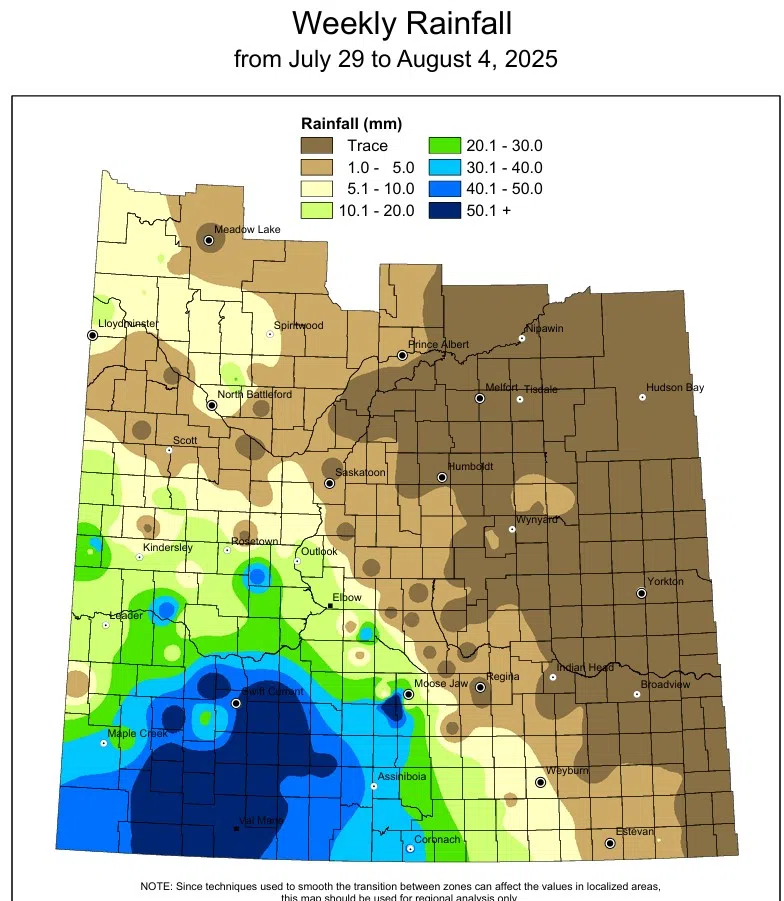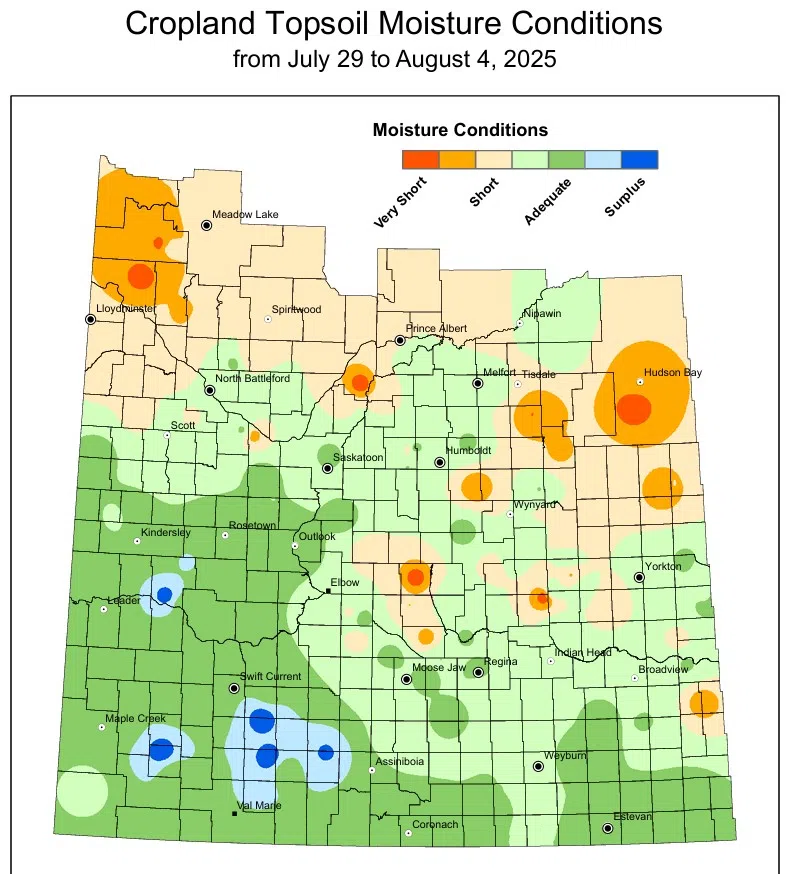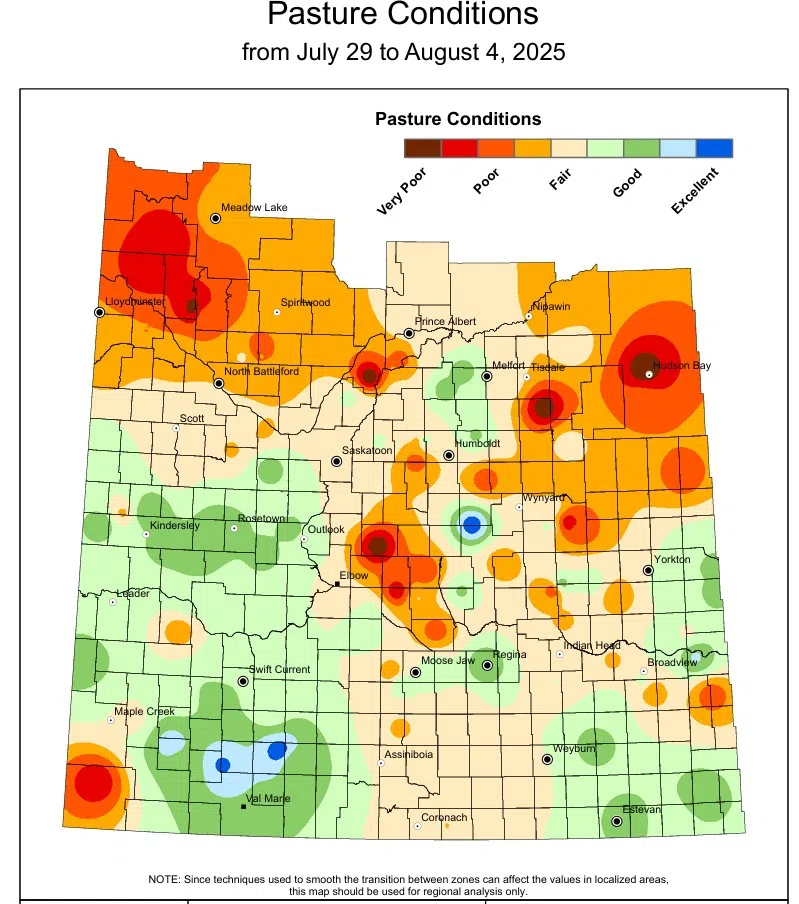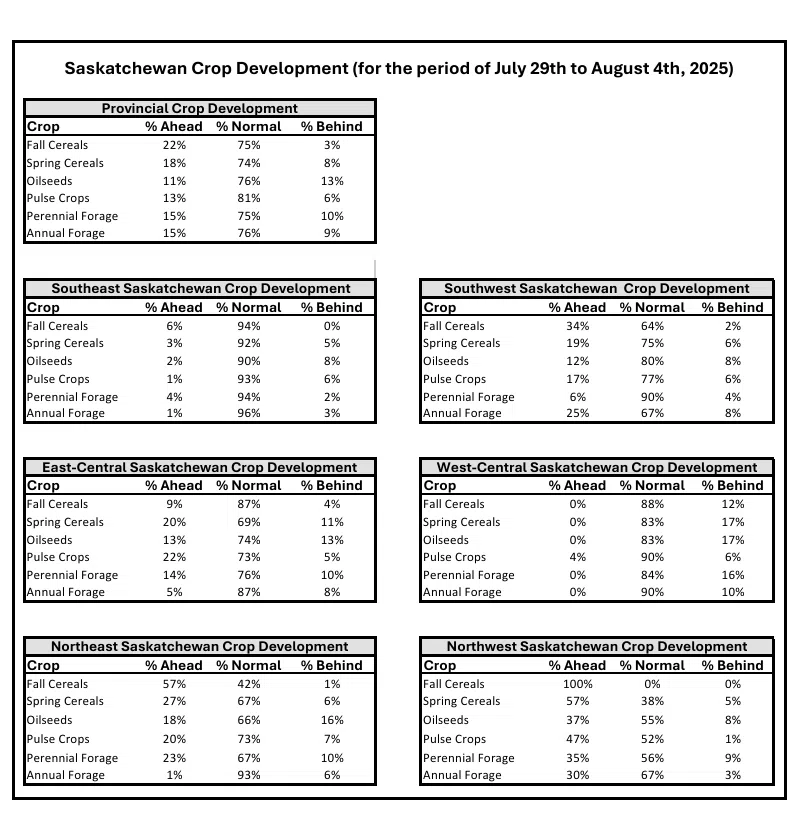
After being dry for much of the year, the southwest received the largest amount of rain last week. The Old Wives area had the most precipitation in the province with 132 millimetres, followed by Vanguard and Cadillac with 119 and 95 millimetres respectively. Most other parts of the southwest had at least 40 millimetres of rain. While too late for many crops in the southwest, the rain is providing a boost to pasture conditions.
In the west-central region, scattered showers helped to fill in crops, but more timely rain is needed to fulfill yield potential. Milden had the most rain at 44 millimetres followed by Marengo with 38 millimetres. Most other locations got about 10 millimetres, but some only received negligible rainfall.
Things are not so good in the northwest which had another relatively dry week. Rabbit Lake did receive 20mm with Glaslyn at 14 millimetres. Cropland topsoil moisture in the northwest is only 23 per cent adequate, 58 per cent short and 19 per cent very short. Fifty-seven per cent of pastures have short topsoil moisture with 33 per cent very short. The northwest has the poorest pasture conditions in the province.



Crop development is variable with many areas anticipating staging issues for harvest.

You can view the entire region-by-region crop report below:
Carnduff, Estevan, Lampman, Redvers and Stoughton areas
Avonlea, Fillmore, Minton, Radville and Weyburn areas
Broadview, Esterhazy, Melville and Moosomin areas
Belle Plaine, Cupar, Lumsden, Indian Head, Regina and Rouleau areas
Many crops are progressing nicely in the Southeast but need timely rain over the next couple of weeks to support seed development. Harvest is top of mind for producers as many are currently preparing equipment and grain storage for the incoming crop.
Last week was a dry week, with only a couple of areas receiving notable rain. The Big Beaver area got the most rain with 21 millimetres (mm), followed by the Radville area with 14 mm. The rest of the southeast had very little rainfall.
Consequently, topsoil moisture levels fell slightly from last week, but conditions remain largely sufficient. Cropland topsoil moisture is currently rated 69 per cent adequate, 26 per cent short, and five per cent very short. Hayland topsoil moisture is 64 per cent adequate, 32 per cent short, and four per cent very short. Finally, pasture topsoil moisture is 62 per cent adequate, 33 per cent short and five per cent very short.
Most crops are at normal growth stages for early August due to the relatively stable moisture conditions throughout the growing season. Currently, fall cereal crops are the furthest ahead and oilseed crops are the furthest behind in crop development.
Most crops are still developing and are not ready to harvest. However, some winter cereal and early seeded pulse crops are reaching maturity and starting to be harvested. Seven per cent of fall rye, two per cent of lentils, and one per cent of peas have been harvested. Despite this small progress, less than one per cent of crops in the southeast have been harvested.
Livestock producers are noting that most pastures are in fair to good condition. Currently, three per cent of pastures are in excellent condition, 31 per cent are good, 53 per cent are fair, 12 per cent are poor and a mere one per cent are in very poor condition.
There was little crop damage reported last week. Only a few crops were stressed from hot and dry conditions, but damage was considered minor to moderate in these cases.
Assiniboia, Gravelbourg, Mankota, Ponteix and Rockglen areas
Cadillac, Consul, Eastend, Maple Creek and Val Marie areas
Beechy, Central Butte, Craik, Herbert, Hodgeville and Moose Jaw areas
Cabri, Elrose, Fox Valley, Leader, Swift Current and Tompkins areas
Plenty of rain fell in the southwest last week, which was welcomed by many producers but came later in the season than they were hoping. Regardless, the rain will benefit later seeded crops and help replenish soil moisture.
The highest rainfall was recorded in the Old Wives area, which got 132 millimetres (mm). The Vanguard Cadillac areas followed closely with 119 mm and 95 mm, respectively. Many other areas recorded more than 40 mm of rain last week as well.
The abundant rainfall significantly increased topsoil moisture levels in much of the region. Cropland topsoil moisture levels are high as 20 per cent have surplus moisture, 66 per cent have adequate levels, 13 per cent are short and only one per cent are very short of moisture. Similarly, hayland topsoil is 19 per cent surplus, 60 per cent adequate, 19 per cent short and two per cent very short. Finally, pasture topsoil moisture levels are 14 per cent surplus, 67 per cent adequate, 16 per cent short and three per cent very short.
The recent rainfall has slowed crop development in later seeded crops and allowed them to reach normal growth stages. Notable portions of fall cereal, spring cereal and pulse crops remain ahead of normal stages due to these crops nearing maturity before the rain.
Harvest of winter cereal crops is in full swing as large portions of winter wheat and fall rye are ready to harvest. Currently, 24 per cent of winter wheat and 13 per cent fall rye have been combined. Early seeded pulse crops are starting to be taken off as two per cent of field peas and one per cent of lentils have been harvested. In total, only two per cent of crops in the southwest have been harvested and many producers will begin harvest in the coming weeks.
The rainfall over the last couple of weeks has improved pasture conditions. Currently, 14 per cent of pastures are in excellent condition, 43 per cent are good, 25 per cent are fair, 10 per cent are poor and eight per cent are in very poor condition.
Damage was reported in a small number of crops last week, with environmental factors being the primary cause. Some fields experienced minor to moderate damage from excess moisture, hot temperatures, hail and wind, but damage was isolated and not widespread.
Biggar, Delisle, Rosetown and Sonningdale areas
Cut Knife, Kerrobert, Kindersley, Macklin, Plenty and Wilkie areas
Scattered showers in the west-central will help grain fill in crops, but more timely rains are needed to fulfill yield potential. Producers are working to prepare equipment and grain storage prior to harvest later this month.
The Milden area received the most rain last week with 44 millimetres (mm), followed by the Marengo area with 38 mm. A few other areas got more than 10 mm, but some areas unfortunately had negligible amounts.
Topsoil moisture dropped slightly last week, but levels remain above the provincial average. Cropland topsoil moisture is 69 per cent adequate, 29 per cent short and two per cent very short. Hayland topsoil moisture is 67 per cent adequate, 31 per cent short and two per cent very short. Finally, pasture topsoil moisture levels are 65 per cent adequate, 33 per cent short and two per cent very short.
Most crops in the west-central are at normal growth stages with almost none being ahead. Notable portions of spring cereals, oilseeds and perennial forages are behind normal development stages. However, the variability in crop development in this region is minuscule compared to the rest of the province. Additionally, nearly all crops in the west-central are still developing and haven’t reached maturity yet.
Pasture conditions in the west-central are some of the best in the province as most of them are in good or fair condition. Currently, 52 per cent of pastures are in good condition, 38 per cent are fair and 10 per cent are in poor condition.
Very little crop damage was observed last week. There were only a couple of isolated reports of dry conditions causing minor damage to certain crops.
Calder, Canora, Pelly, Preeceville, Sheho and Yorkton areas
Foam Lake, Kelliher, Leroy, Raymore and Wadena areas
Davidson, Colonsay, Langham, Lanigan, Nokomis, Outlook and Saskatoon areas
Last week was hot and dry for most of the east-central as some early-seeded crops are approaching maturity. Livestock producers are wrapping up with haying while grain farmers are preparing for harvest.
Similar to the southeast, only a couple of places in the east-central recorded notable rainfall. The Hanley area got the most rain with 20 millimetres (mm) while the Outlook area got 16 mm. There was virtually no rainfall recorded in the rest of the region.
The dry week caused topsoil moisture levels to noticeably decrease from last week. Currently, topsoil moisture levels for cropland is 46 per cent adequate, 38 per cent short and 16 per cent very short. Hayland topsoil moisture levels are 51 per cent adequate, 32 per cent short and 17 per cent very short. Pasture topsoil moisture levels are now 42 per cent adequate, 27 per cent short and 31 per cent very short.
More crops are ahead of normal growth stages than two weeks ago due to the warm and dry conditions accelerating development over this time. Spring cereals, oilseeds and pulses had the highest increase in acreage of crops ahead, but well over two-thirds of crops remain at normal stages.
Nearly all spring-seeded crops are not yet ready to harvest, but fall cereals are starting to reach maturity. Currently, 18 per cent of winter wheat and seven per cent of fall rye have been harvested.
Pastures greatly vary in the east-central as some areas have pastures in good to fair condition while others are in poor condition. Currently, two per cent of pastures are in excellent condition, 24 per cent are good, 31 per cent are fair, 26 per cent are poor and 17 per cent are very poor. Rain in dry areas is needed to improve subpar pasture conditions.
There was damage to a few crops in the east-central last week with hot temperatures, dry conditions and wind causing minor to moderate damage. However, damage was localized in certain parts of the region and not widespread.
Choiceland, Hudson Bay, Kelvington, Melfort, and Nipawin areas
Cudworth, Humboldt, Kinistino, Prince Albert, Rosthern and St. Brieux areas
Hot and dry conditions are taking a toll on many crops in the northeast, and rain is needed soon to support seed development. Very little rainfall was recorded in the region, with only a few areas getting small showers. Producers are preparing for harvest as some expect to begin in the next couple of weeks.
Soil moisture levels continue declining due to persistent dry conditions. Cropland topsoil moisture levels fell to 30 per cent adequate, 51 per cent short and 19 per cent very short. Hayland topsoil moisture is now 28 per cent adequate, 44 per cent short and 28 per cent very short. Pasture topsoil moisture levels are 25 per cent adequate, 48 per cent short and 27 per cent very short.
The inconsistent moisture conditions throughout the growing season continues to cause variability in crop development. Large portions of many crop types are ahead of normal development stages. Additionally, notable portions of oilseed and perennial forage crops are behind normal development stages as well. It is likely too late for early seeded crops to see much of a yield benefit from rain, but moisture could help later seeded cereal and oilseed crops finish developing. So far, no crops have been harvested in the northeast this year.
Like crop development, pasture conditions vary throughout the northeast. Twenty-one per cent of pastures are in good condition, 41 per cent are fair, 23 per cent are poor and 15 per cent are in very poor condition.
The presence of crop damage and severity varies within the region. Environmental factors such as dry conditions and hot temperatures are causing most of the crop damage observed in the northeast.
Blaine Lake, Canwood, North Battleford, Radisson and Spiritwood areas
Glaslyn, Maidstone, Meadow Lake, Pierceland and St. Walburg areas
It was a dry week in much of the northwest as crops are rapidly maturing and struggling to produce seed. Grain farmers are preparing equipment for harvest while livestock producers are busy moving cattle and hauling water.
The Rabbit Lake area got the most rain in the northwest with 20 millimetres (mm), followed by the Glaslyn area with 14 mm. The Hillmond and Loon Lake areas both got 11 mm while the Paradise Hill area got 10 mm. The rest of the region had minimal rain and remains dry.
The northwest remains the driest region in the province as soil moisture levels continue to decline. Cropland topsoil moisture is 23 per cent adequate, 58 per cent short and 19 per cent very short. Hayland topsoil moisture is a mere eight per cent adequate, 60 per cent short and 32 per cent very short. Finally, pasture topsoil moisture is 10 per cent adequate, 57 per cent short and 33 per cent very short.
The northwest has the highest portion of crops ahead of normal development stages in the province. Nearly all fall cereals are ahead of normal stages, along with large portions of other crop types. Despite how advanced many crops are, producers haven’t started harvesting crops yet.
Most pastures in the northwest are currently in rough shape. Only five per cent are in good condition and 25 per cent are fair, while 45 per cent are poor and 25 per cent are in very poor condition. Unfortunately, the northwest has the poorest pasture conditions in the province this year.
Like other parts of the province, dry conditions paired with hot weather is causing varying levels of crop damage in the northwest which continues to hurt yield potential. There are a few reports of grasshoppers causing minor to moderate damage in certain areas as well.
























